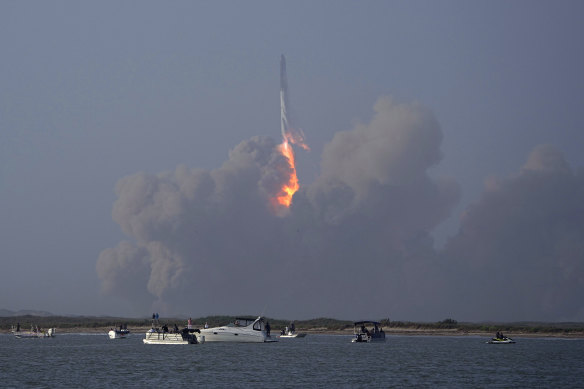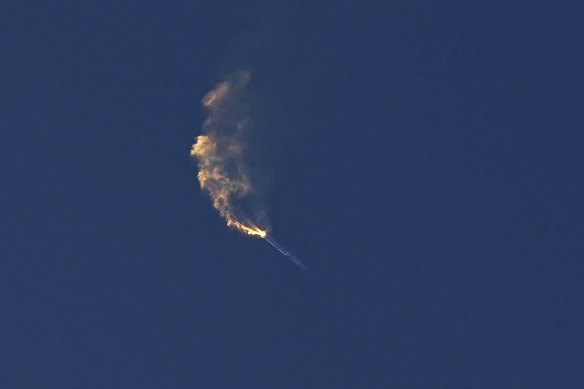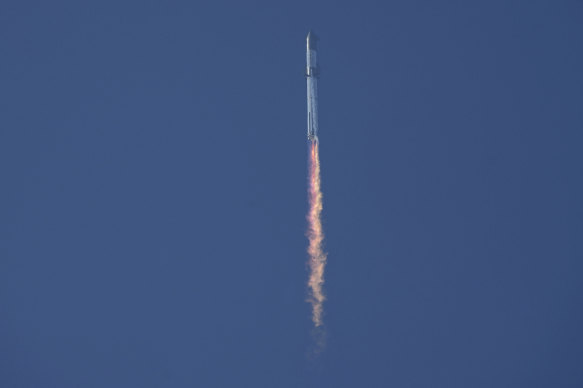By Marcia Dunn
South Padre Island, Texas: SpaceX’s giant new rocket exploded minutes after blasting off on its first test flight and crashed into the Gulf of Mexico.
Elon Musk’s company was aiming to send the biggest and most powerful rocket ever built on a round-the-world trip from the southern tip of Texas, near the Mexican border. The nearly 120-metre Starship carried no people or satellites.

SpaceX’s Starship launches from Starbase in Boca Chica, Texas.Credit: AP
Images showed several of the 33 main engines were not firing as Starship climbed from the launch pad, reaching as high as 39 kilometres on Thursday (US time). There was no immediate word from SpaceX on how many engines failed to ignite or shut down prematurely.
The booster was supposed to peel away from the spacecraft three minutes after lift-off, but that didn’t happen. Rather, the rocket with the spacecraft still attached began to tumble and then exploded, plummeting into the water.
Instead of a best-case-scenario 1.5-hour flight with the spacecraft taking a lap around the world, the whole thing lasted four minutes. It reached a maximum speed of about 2100km/h.
Throngs of spectators watched from South Padre Island, several miles away from the Boca Chica Beach launch site, which was off-limits. As Starship lifted off with a thunderous roar, the crowd screamed: “Go, baby, go!”
Musk, in a tweet, called it “an exciting test launch of Starship! Learned a lot for next test launch in a few months.”
In the weeks leading up to the flight, Musk gave 50:50 odds that the spacecraft would reach orbit and not end up in what SpaceX calls a “rapid unscheduled disassembly”. He said not blowing up the launch pad would be a win.
“You never know exactly what’s going to happen,” said SpaceX livestream commentator and engineer John Insprucker. “But as we promised, excitement is guaranteed and Starship gave us a rather spectacular end.”
The company intends to use Starship to send people and cargo to the moon and, eventually, Mars. NASA has reserved a Starship for its next moonwalking team, and rich tourists are already booking lunar flybys.

The Starship exploded minutes after launch.Credit: AP
Despite the abbreviated flight, congratulations poured in from NASA chief Bill Nelson and others in the space industry. Retired Canadian astronaut Chris Hadfield tweeted, “Huge accomplishment, huge lessons, onwards to the next attempt.”
“It fell somewhere between a small step and their hoped-for giant leap, but it still represents significant progress toward a reusable super-heavy lift rocket,” University of Chicago’s Jordan Bimm, a space historian, said in an email.
At 120 metres and 7.6 million kilograms of thrust, Starship easily surpasses NASA’s moon rockets — past, present and future. NASA successfully launched its new 98-meter moon rocket last November on a test flight, sending the empty Orion capsule around the moon.
The stainless-steel Starship rocket is designed to be fully reusable with fast turnaround, dramatically lowering costs, similar to what SpaceX’s smaller Falcon rockets have done soaring from Cape Canaveral, Florida. Nothing was to be saved from this test flight, with the spacecraft — if all had gone well — aiming for a watery grave in the Pacific near Hawaii.
The futuristic spacecraft flew several kilometres into the air during testing a few years ago, landing successfully only once. But this was to be the inaugural launch of the first-stage booster with 33 methane-fuelled engines.

SpaceX’s Starship after blast-off.Credit: AP
SpaceX has more boosters and spacecraft lined up for more test flight; the next set is almost ready to go. Musk wants to fire them off in quick succession, so he can start using Starships to launch satellites into low-Earth orbit and then put people on board.
It was the second launch attempt. Monday’s try was scrapped by a frozen booster valve.
Jason and Lisa Flores drove down from Corpus Christi to watch the launch with their daughter, and noticed something was amiss.
Lisa Flores cried seeing the lift-off and then realised, “It’s not working out the way it was supposed to.”
Elizabeth Trujillo, 13, wearing a Star Wars shirt and carrying toy binoculars, skipped school to see the launch from the beach with her mother and other relatives. The crowd cheered when Starship cleared the tower.
Despite the failed attempt, “it was worth it,” said Jessica Trujillo, Elizabeth’s mother. “Just hearing and seeing the view, the excitement of the crowd, it was priceless.”
“Practice makes perfect. They just got to practise some more,” she added.
AP
The Business Briefing newsletter delivers major stories, exclusive coverage and expert opinion. Sign up to get it every weekday morning.